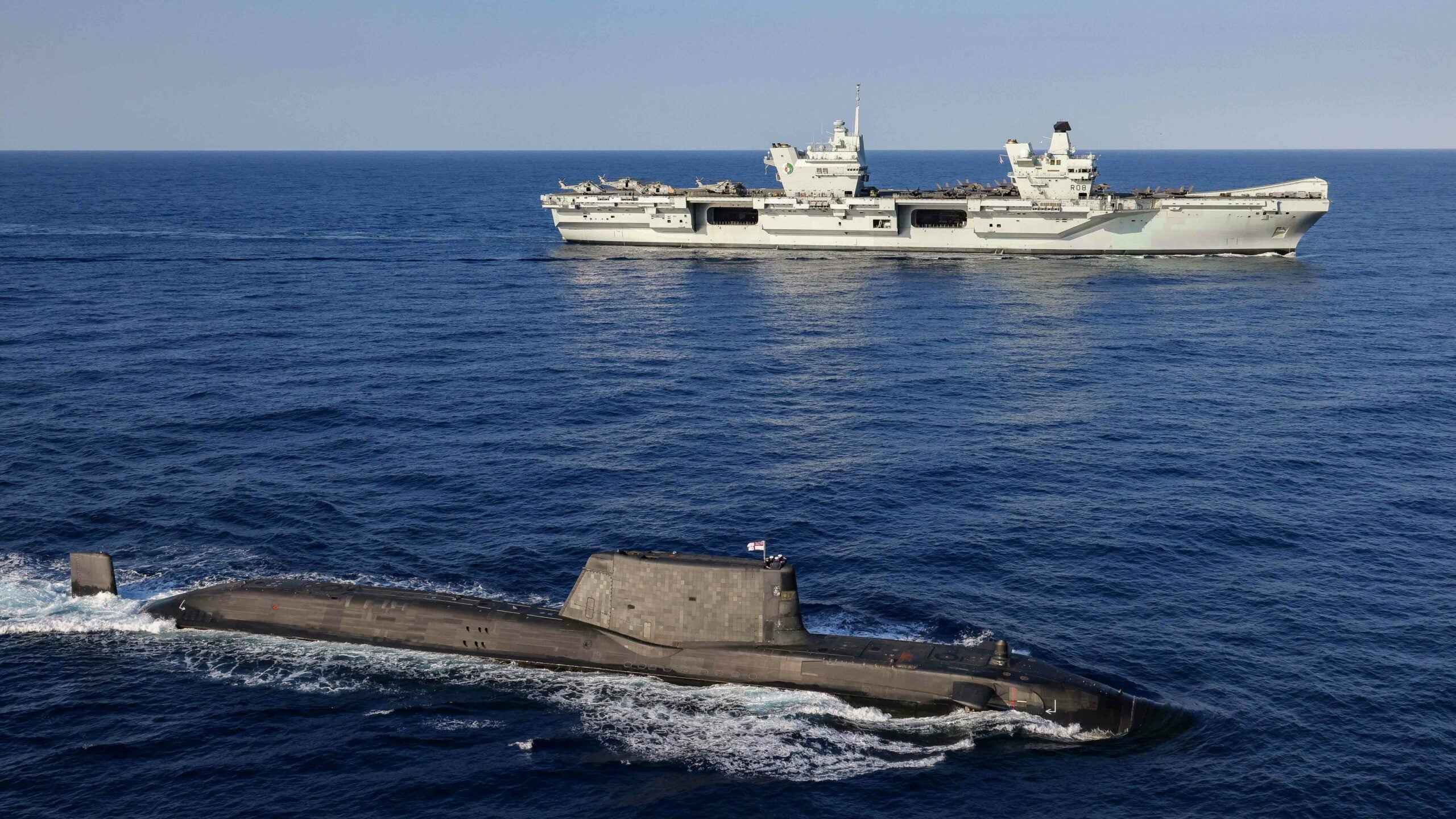Satellite imagery has emerged that indicates that the U.K. Royal Navy aircraft carrier HMS Queen Elizabeth is underway in the South China Sea while the Chinese People’s Liberation Army Navy flattop Shandong is also in these waters, though the two ships look to be sailing on opposite sides of the disputed body of water, at least for now. The appearance of the British flagship in the South China Sea had been anticipated, but it still carries a significant message as the United Kingdom and its allies look to further challenge China’s expansive territorial claims in this region.
Using satellite imagery provided by the European Space Agency and NASA/U.S. Geological Survey, Twitter user @duandang appears to have located the two aircraft carriers in the South China Sea, separated by around 580 nautical miles of water. The Shandong looks to be underway just south of Hainan Island, where it is home-ported within a huge People’s Liberation Army Navy (PLAN) base. Meanwhile, the imagery indicates that HMS Queen Elizabeth is somewhere between the coast of Vietnam and the island of Borneo.
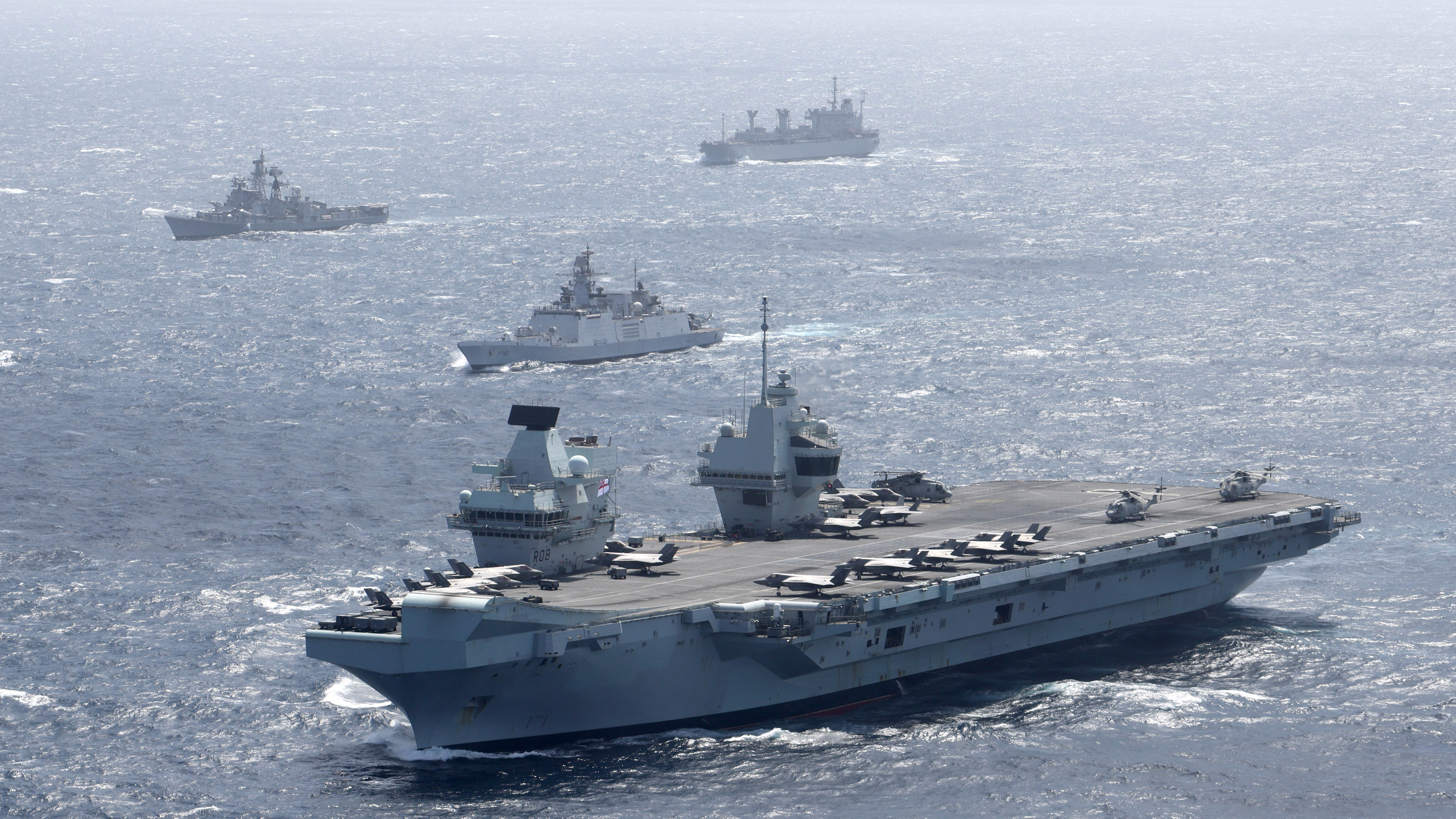
According to the Hong Kong-based South China Morning Post, HMS Queen Elizabeth entered the South China Sea for the first time on Monday. The same source noted that the “relationship between Beijing and London is expected to deteriorate further as Britain carries out military and economic actions that frustrate Beijing’s ambitions” in this region. On the British side, there has apparently been no official confirmation so far of CSG21’s presence in these waters.
HMS Queen Elizabeth is currently undertaking its first operational cruise, as part of Carrier Strike Group 21 (CSG21), which also includes the Royal Navy Type 45 destroyers HMS Diamond and HMS Defender, the Type 23 frigates HMS Northumberland and HMS Kent, an Astute class nuclear-powered attack submarine (apparently HMS Artful), and two Royal Fleet Auxiliary support ships, RFA Tideforce and RFA Fort Victoria.
Also within CSG21 are the U.S. Navy’s Arleigh Burke class destroyer USS The Sullivans and the Dutch Navy’s De Zeven Provincien class destroyer HNLMS Evertsen.
Meanwhile, HMS Queen Elizabeth is embarking eight F-35B short takeoff and vertical landing (STOVL) stealth fighters from the U.K. Royal Air Force (RAF). There are another 10 of these jets onboard the ship from the U.S. Marines Corps’ Marine Fighter Attack Squadron (VMFA) 211, the “Wake Island Avengers,” which is currently under British command.
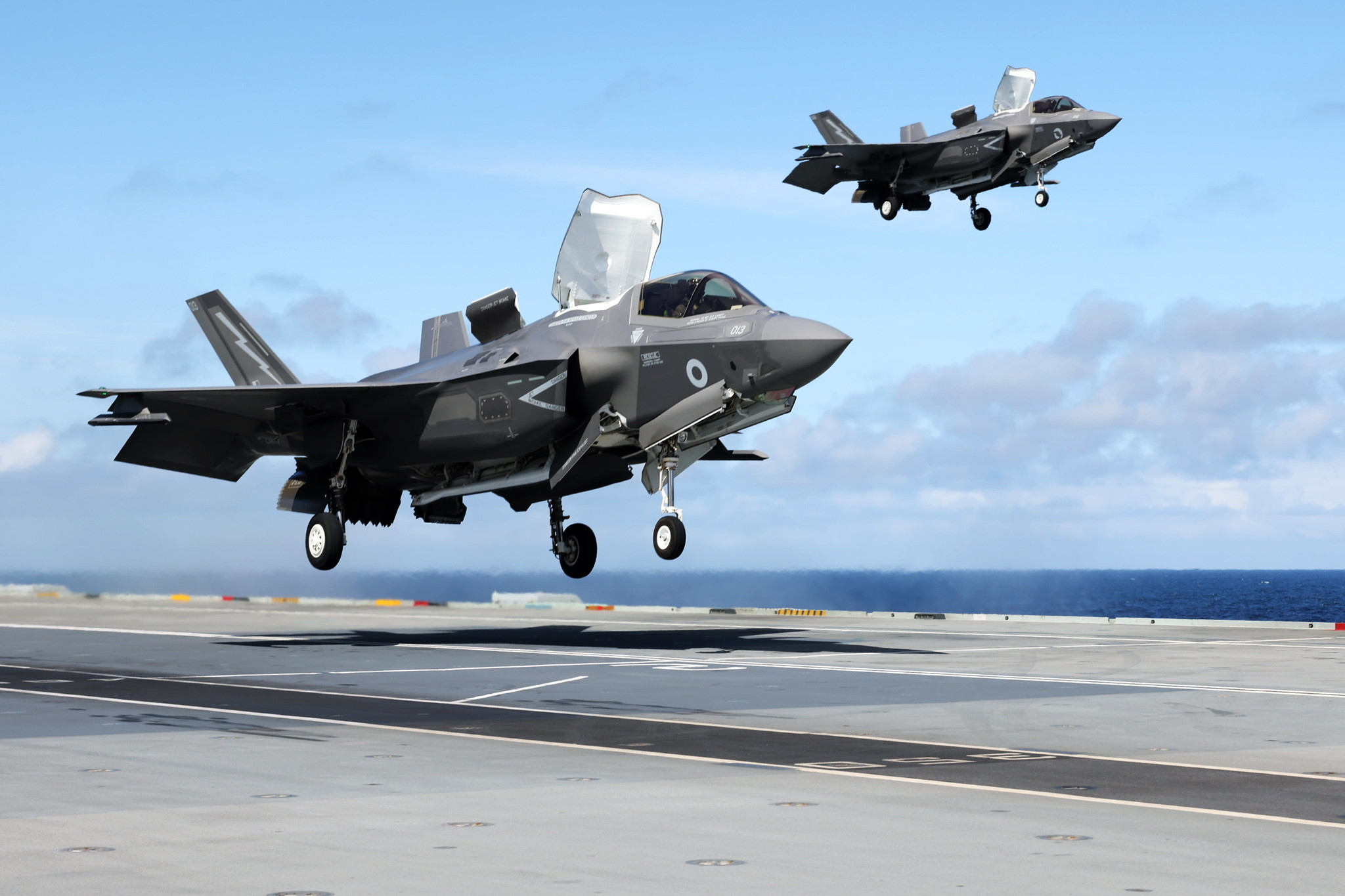
Royal Navy rotary-wing assets comprise Wildcat HMA2 multirole helicopters, anti-submarine warfare and airborne early warning and control Merlin HM2 helicopters, and Commando Merlin helicopters. Other helicopters are assigned to the U.S. Navy and Dutch Navy destroyers within CSG21, too.
At the same time that CSG21 appears to be underway in the South China Sea, these same waters are also hosting a U.S. Navy Surface Action Group, or SAG, which is drawn from three U.S. 7th Fleet task forces and includes the Arleigh Burke class destroyer USS Kidd and the Independence class Littoral Combat Ship (LCS) USS Tulsa. This is, according to the Navy, the first time a deployed LCS and a guided-missile destroyer have joined to form a surface task group, with the LCS having had a notably troubled service career so far.
Although unconfirmed, there are meanwhile reports of PLAN maneuvers underway around Hainan, which could involve the Shandong. This is China’s second aircraft carrier, constructed in China along very similar design principles to the former Kuznetsov class carrier Liaoning, and which has been in service since late 2019.
If it is taking part in an exercise of significant size and scope, the Shandong would also be accompanied by its own support assets. When the carrier’s sister vessel, Liaoning, was underway in Japan’s Miyako Strait earlier this year, it was reportedly joined by two Type 052D Luyang class destroyers, one Type 055 Renhai class destroyer, one Type 054A Jiangkai class II frigate, and one Type 901 Fuyu class fast combat support ship.
That CSG21 would enter the South China Sea had long been expected, as part of the 26,000-nautical-mile cruise that plans to take in visits to 40 nations, as well as various bilateral and multinational exercises.
In a statement in April, U.K. Defense Secretary Ben Wallace said: “When our Carrier Strike Group sets sail next month, it will be flying the flag for Global Britain — projecting our influence, signaling our power, engaging with our friends and reaffirming our commitment to addressing the security challenges of today and tomorrow.”
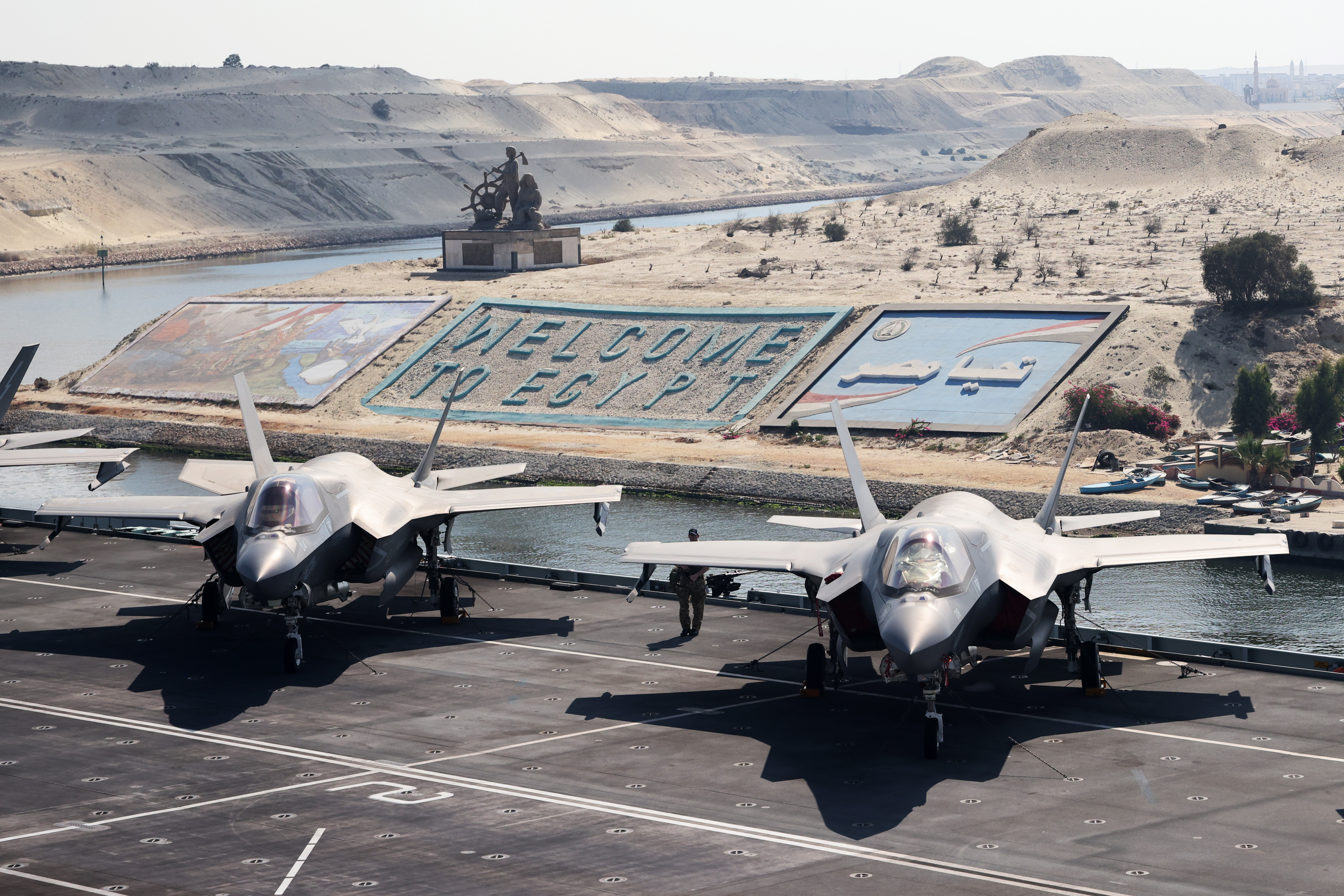
Although not making specific reference to the South China Sea, before the departure of CSG21, the U.K. Ministry of Defense also noted that the deployment was “intended to bolster already deep defense partnerships in the Pacific region, where the UK is committed to a more enduring regional defense and security presence.”
The arrival of CSG21 is part of a wider uptick in U.K. interest in the South China Sea, and the Royal Navy plans to permanently assign two Offshore Patrol Vessels, HMS Spey and HMS Tamar, to the Indo-Pacific region from August this year, as well as contributing a Littoral Response Group (LRG) in the future.
The United Kingdom, alongside the United States and other allies, both regional and interregional, have been keeping a close eye on developments in the South China Sea, where the waters have long been disputed, with competing territorial claims from China as well as Brunei, Malaysia, the Philippines, Taiwan, and Vietnam.
In particular, the island chains of the Paracels and the Spratlys, home to significant natural resources, are subject to claims by different nations, while there are also territorial disputes over a variety of atolls, sandbanks, and reefs, including the Scarborough Shoal, which is subject to a dispute between the Philippines and China.
As part of its wide-ranging claims in the region, manifested in the “nine-dash line,” China has embarked on efforts to build and arm artificial islands, as well as stepping up naval patrols by its warships and aircraft.
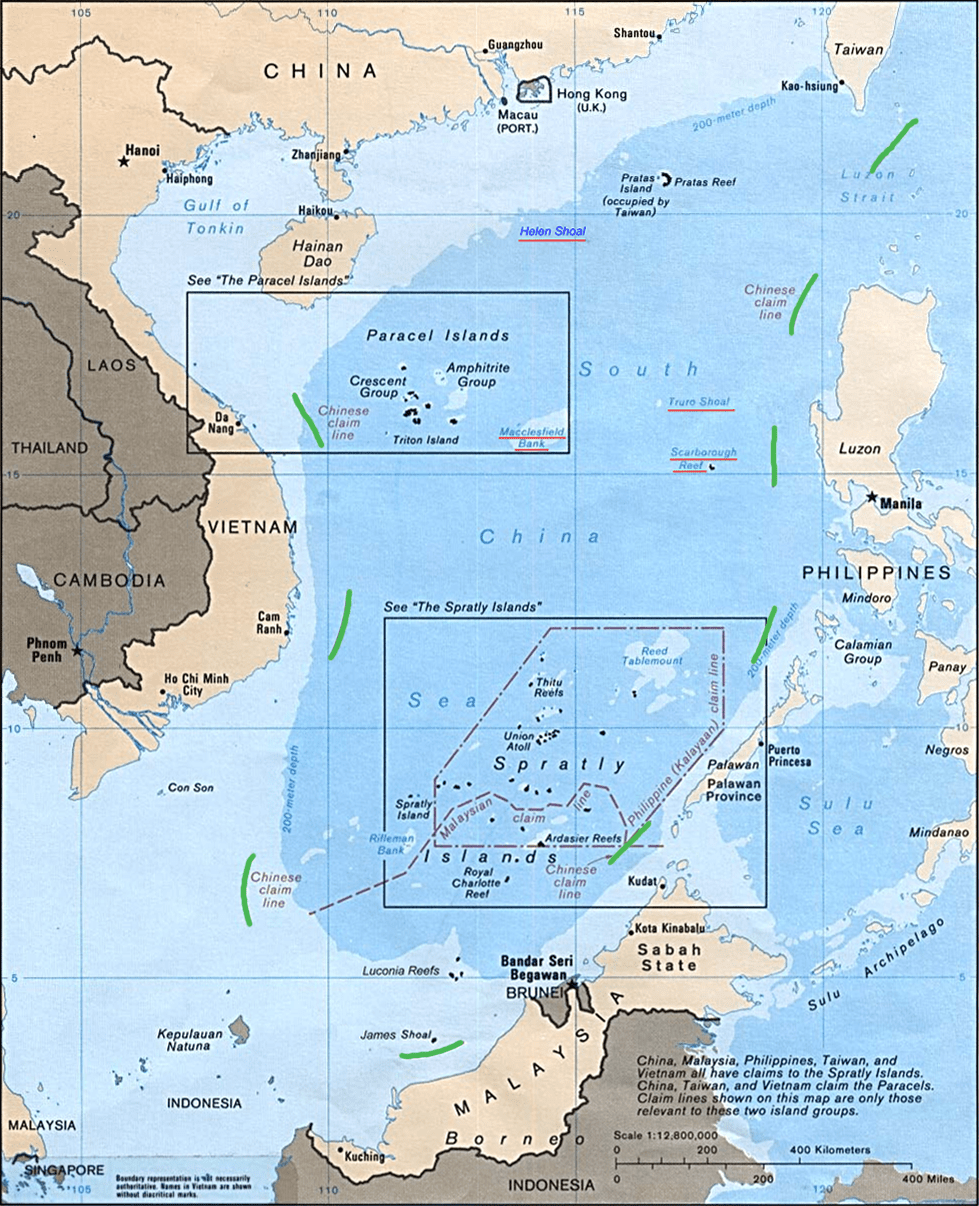
In response, the U.S. Navy, in particular, has sent military vessels and aircraft on “freedom of navigation” operations, or FONOPs, in the South China Sea, demonstrating its commitment to keeping access open to vital shipping and air routes. With a variety of vessels and aircraft involved, CSG21 is now well placed to carry out similar operations, with the option for elements of CSG21 to break away and potentially take part in their own FONOPs, as HMS Daring and HNLMS Evertsen did recently in the Black Sea.
Earlier this year, the Theodore Roosevelt Carrier Strike Group and the Makin Island Amphibious Ready Group (ARG) conducted a coordinated exercise in the South China Sea, while the Liaoning and its carrier strike group were in the same waters. At the same time, China and the Philippines were involved in a dispute as more than 200 Chinese vessels occupied an area in the West Philippines Sea known as Whitsun Reef.
As the U.S. State Department expressed its concern about China’s maritime activities, China’s foreign minister spokesman Zhao Lijian responded accused the United States of “inciting quarrels and sowing discord.”

The PLAN has also been increasingly assertive recently in enforcing its disputed claims in the region, including reports from Beijing that its military chased an American warship out of the South China Sea. While that is disputed, the potential risks for anyone conducting FONOPs are clear.
Against the backdrop of these developments, and accusations of militarization of the South China Sea from different parties, it’s not surprising that many analysts have identified the area as a potential flashpoint and one which could have enormous repercussions.
All in all, the strategic and economic significance of the South China Sea is beyond doubt and it’s now clear that the United Kingdom, too, is increasingly willing to show its presence in these waters, within which it has been estimated that up to a third of all maritime trade passes, by volume.
Before it arrived in the South China Sea, CSG21 had taken part in Exercise Konkan with the Indian Navy in the Bay of Bengal. As it passed Singapore, heading east, there was a chance to take part in drills with the Republic of Singapore Navy, which provided the Formidable class frigate RSS Intrepid, the Independence class littoral mission vessel RSS Unity, and the Endurance class landing ship tank RSS Resolution.
Other recent maneuvers included linking up with one of her American counterparts, the Nimitz class USS Ronald Reagan, as well as the Wasp class amphibious assault ship USS Iwo Jima, among other warships, for a major exercise in the Gulf of Aden, which you can read about here. Somewhat unusually, there is currently no U.S. Navy carrier presently operating anywhere in the Western Pacific.
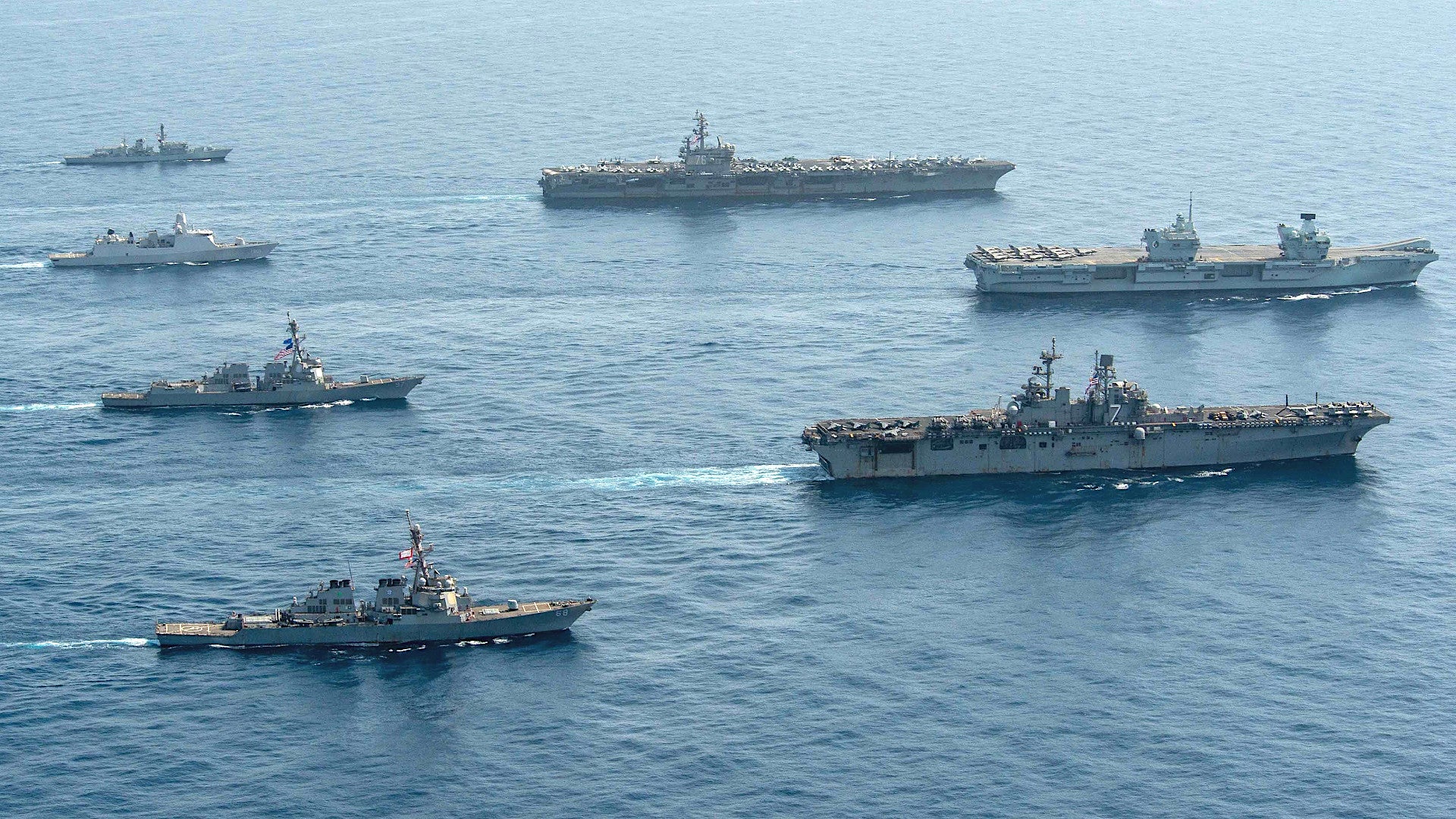
In previous weeks, CSG21 had been active in the eastern Mediterranean, where it launched its first combat missions, its F-35Bs joining the international coalition fighting ISIS in the Middle East. While in the Mediterranean, the Carrier Strike Group also attracted attention from Russian Navy assets based in Syria, while Russian warships were in turn shadowed by the carrier’s F-35Bs.
So far, CSG21’s activities in the South China Sea have been low-profile, but that may well change, and it also remains to be seen just how Beijing will respond to this new development.
July 30: China has now issued a formal response to operations by CSG21 in the South China Sea. “The action should never try to destabilize regional peace, including the latest military collaboration between the UK and Japan,” Wu Qian, a spokesman from China’s Ministry of Defense, said. “The Chinese navy will take any necessary actions to counter-measure such behavior.”
Meanwhile, China’s Global Times has issued a report declaring that “the very idea of a British presence in the South China Sea is dangerous.” The report warns that “If London tries to establish a military presence in the region with geopolitical significance, it will only disrupt the status quo in the region […] And if there is any real action against China, it is looking for a defeat.”
So far, the U.K. Ministry of Defense has not issued a direct statement about CSG21 now being in the South China Sea. However, Commodore Steve Moorhouse, commander of the U.K. Carrier Strike Group tweeted on July 27 that “Last night we also passed close to the resting place of the previous Prince of Wales and Repulse.”
Those two warships were sunk by the Japanese in the South China Sea during World War II and now rest off the coast of Malaysia.
Contact the author: thomas@thedrive.com
